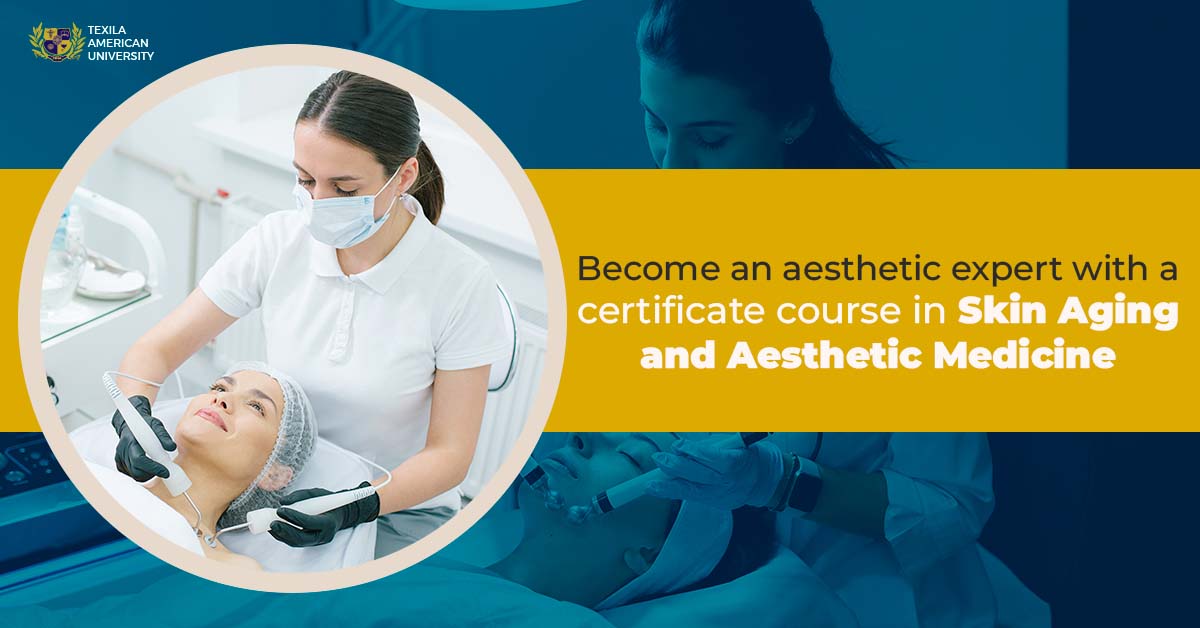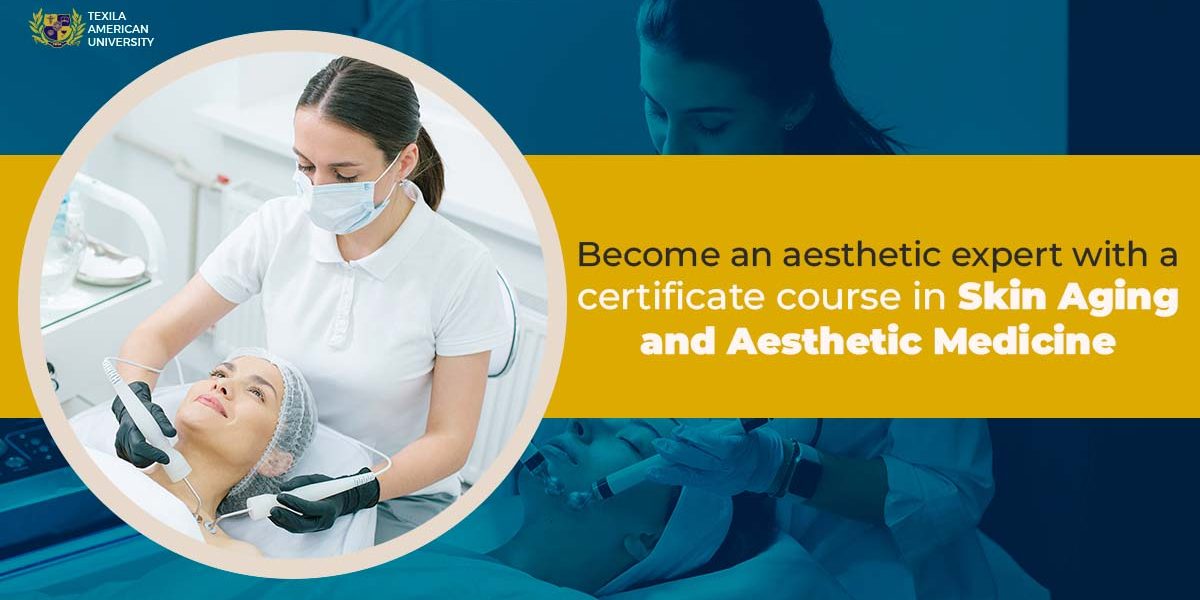Blog Summary:
Aesthetic or cosmetic treatments are non-invasive procedures developed to deal with signs of aging, rejuvenate and refresh skin. Aesthetic practitioners do not perform cosmetic or plastic surgery. Minimally invasive cosmetic procedure to enhance physical appearance is gaining popularity globally. Injection procedures – botox and dermal fillers, non-invasive procedures – chemical peels, micro-needling, PDO thread lifts, flawless high-frequency procedures, weight management, etc. are some of the commonly used aesthetic procedures to enhance the beauty. Aesthetic medicine is an evolving industry. Minimally invasive cosmetic procedures are gaining popularity with people from all sectors, increasing the demand for highly skilled and qualified professionals. Pursuing a certification program will help you excel in the field.
Until a decade ago, students who aspired to study skin medicine specialized in dermatology or plastic surgery. The introduction of aesthetic medicine, a clinical subspeciality, offers a lucrative career choice for students and professionals. Medical and non-medical graduates can pursue a skin aging certificate program to become competent skin aesthetic practitioners or beauty experts in clinical skin treatment.
With a lack of awareness, you might often confuse cosmetic processes with plastic surgery. You need to know the differences in these clinical subspecialties to make the right choices for a fruitful career. Aesthetic medicine has seen significant developments in the past decade and employs cutting-edge minimally invasive techniques.
Aesthetic practitioners do not perform cosmetic or plastic surgery. You are required to possess excellent knowledge of skin, beauty and aging and aesthetic instincts. Minimally invasive cosmetic procedure to enhance physical appearance is gaining popularity globally. Botox, hyaluronic acid fillers, laser therapy for hair removal, skin resurfacing, pigmentation removal, treatment to improve skin tone, etc., are trending.
Several institutes offer master’s degree in aesthetic medicine or certificate course in skin aging and aesthetic medicine via full-time and online modes. It’s a lucrative career choice for plastic surgeons, dental practitioners, dermatologists and even non-medical graduates.
You will work with a team from multiple disciplines to care for accident and burn victims who have to deal with scars, disfigurement and trauma. You will be working to improve your patient’s physical appearance, reduce scars and reconstruct disfigured areas. But most of the time, you need to work with healthy individuals who prefer to enhance their physical appearance by correcting facial features like chin, lips and nose or undergoing procedures to look young. People in the entertainment and media industries prefer to undergo minimally invasive procedures with the constant urge to look good. Demand for non-surgical procedures increases the need for qualified specialists with certifications in the field.
Career Opportunities:
- Qualified aesthetic practitioners are in high demand in beauty spas and clinics.
- Opportunities in dermatological clinics to perform exfoliation, removal of pre-cancerous, or offer restorative treatments.
- Opportunities in hospitals or clinics to provide pre-operative and post-operative skin care for patients undergoing plastic surgery
Aesthetic or cosmetic treatments are non-invasive procedures developed to deal with signs of aging, rejuvenate and refresh skin. Botox injections and dermal fillers are the most commonly used treatments to look young. Individuals mostly undergo treatment on the face, neck and lower neckline. Procedures can also help with excessive sweating, remove pigmentation, treat acne, scars, skin tags, moles, etc.
Skin Assessment:
A thorough facial analysis helps you determine the skin care needs and procedures to ensure optimal results.
Injection procedures:
Botox injections: Botulinum toxin injections reduce the appearance of wrinkles by relaxing the muscle groups causing them. The serum is injected into the areas around the eyes, frown lines and forehead. The injections need to be taken every 4 – 6 months for best results.
It’s used to treat:
- Underarm sweating
- Severe neck and shoulder muscle spasms
- Blinking disorder
- Chronic migraine
- Overactive bladder
Botulinum toxin injections cause temporary side effects during the initial two weeks of taking the injections. Pregnant, breastfeeding and people allergic to cow milk protein should refrain from taking the injections.
Dermal fillers: Dermal filler injections reduce the formation of wrinkles, restore volume, smoothen creases and enhance facial features by filling them. The serum is gel-based and injected beneath the skin of the lips, cheeks, nose to mouth lines and below mouth lines. It can also be injected into the areas around the eyes, frown lines and forehead.
Benefits of using dermal fillers:
- Smoothens lines around nose, mouth and chin crease
- Enhances and restores volume to sunken cheeks, lips and temples
- Enhances facial symmetry
Fillers are categorized based on the core substance they are made of. The different types of dermal fillers available are Hyaluronic acid, calcium hydroxylapatite, poly-L-lactic acid, polymethylmethacrylate (PMMA), etc. A facial analysis will help you determine the suitable therapy and dermal filler to suit your patient’s skin care needs. The dermal filler injections need to be taken every 4 – 6 months for best results.
Non-Invasive procedures:
Chemical peels: Naturally derived acids are applied to the areas to stimulate and remove unwanted or dead skin cells. This procedure is adopted to treat several skin problems like wrinkles, pigmentation, scars and acne.
Differentiated based on the depth of application:
Light chemical peel removes the topmost layer of the skin from epidermis and gives the best results for wrinkles, acne, uneven skin tone and dryness. The process needs to be repeated every month.
Medium chemical peel removes skin cells from the epidermis and upper layer of the dermis and used to treat wrinkles, acne, scars and uneven skin tone. The process needs to be repeated for the best results.
Deep chemical peel helps remove skin cells from the lower layers of the skin, deeper wrinkles, scars or precancerous growth. Repeat procedures are not required.
Micro-needling: Tiny needles placed on the outer dermal layers stimulate skin cells. This procedure helps treat open pores, scars, stretch marks, sun damage, and uneven skin problems.
PDO Thread Lifts:
Have you heard of a facelift? It’s the process of lifting parts of the face- forehead, cheeks, jowls, jawline, neck and body areas like breast using different thread structures. Smooth thread structure improves skin texture; barbs or anchor thread structures reposition tissues. Threads made of Polydioxanone (PDO) stimulate collagen production and dissolve over time.
Flawless high-frequency procedure:
An electrical current passed through a small needle is applied on areas of unwanted thread veins, moles and skin tags, which enables smooth removal or closure.
Weight management:
You can prescribe medications or injections to patients to address obesity and advise them on healthy eating habits.
Nurse medical prescriber:
If you are a registered nurse qualified to prescribe medicines, you can discuss health conditions, emotional wellness, sleep and hormonal issues such as menopause with your patients.
Alternative medical practitioners can prescribe various essential oils to address different health conditions.
Aesthetic medicine is a rapidly evolving and competitive field where expertise and skill to deliver quality service are vital. Texila CPDs Certificate course in skin aging and aesthetic medicine enhances your knowledge in:
- Fundamentals of aesthetic medicine
- Various treatment techniques and procedures involved
- Analytical and decision-making to avoid complications
With a six-month course duration, it’s the best aesthetic program which includes webinars with expert faculty in the following areas:
- Management of photodamaged skin
- Lower face and neck rejuvenation
- Management of facial melanosis
- Facial scars and Keloid and management
The course curriculum of the skin aging certificate program is comprehensive and helps you gain knowledge in physiology and analysis of facial structures, anatomy of cell structures, mechanism of skin aging, facial muscle movement, facial rejuvenation, disinfection and sterilization procedures, the various tools and techniques to treat skin aging and enhance aesthetics with tips to set up a skin clinic.
Key takeaways:
Aesthetic medicine is an evolving industry. Minimally invasive cosmetic procedures are gaining popularity with people from all sectors, increasing the demand for highly skilled and qualified professionals. Pursuing a certification program will help you excel in the field. Upon successful completion of the certificate course in skin aging and aesthetic medicine, gain exposure to:
- Fundamentals of skin aging
- Facial anatomy
- Analysis of facial structures, associated problems, and planning procedures
- Facial anesthesia and various anesthetic procedures
- Latest skin rejuvenation and scientific techniques
- Chemical peel procedures
- Basic chemistry and application of Botulinum toxin
- Different dermal fillers and techniques
- Complications and challenges involved with injections and ways to tackle it
- Laser technology in aesthetic procedures
- Evidence-based medicine in aesthetic surgery
- Setting up a skin clinic


